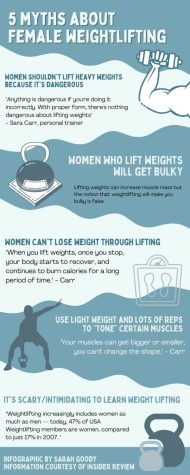Removing the masculinity from muscularity
October 3, 2022
Scrolling through TikTok, one can find a multitude of videos applicable to almost every niche. In recent years, amongst the comedic videos and dance fads, a new trend has emerged: female weightlifters. These influencers have taken to TikTok and other virtual platforms, breaking down the stigmas surrounding weightlifting and encouraging more female representation in the gym. In years past, it was less common to see women weightlifting, but recently (and perhaps as a result of its increasing popularity on social media), high school girls have begun taking up the sport of bodybuilding.
The increasing popularity of weightlifting among females has highlighted problems with how society views femininity and muscularity. A September Bark survey found that 62 percent of students consider muscularity to be a masculine trait, and 16 percent strongly consider muscularity to be a masculine trait. Masculinity and muscularity are often used synonymously, thus damaging the mental health of females and people who don’t identify as male.
Weightlifting contradicts the current, outdated definition of femininity. Since the late 19th century, women have been expected to uphold an unrealistic depiction of femininity: a slender waist, small stature and to assume the role of a maternalistic figure, among other traits. While weightlifting doesn’t always result in weight gain, bodybuilding can usually increase one’s muscle and strength, opposing the fragility and gentleness often defining femininity; it has been ingrained in society that weightlifting is not an activity for women.
I first started weightlifting in the spring of 2021, and throughout my time spent at the gym, I witnessed firsthand how girls can be discouraged from bodybuilding due to the fear of being undesirable to men or “too bulky,” In the beginning, I was advised by men and women not to bench press because it would result in the loss of my chest. Instead, I was supposed to prioritize glute growth over quad growth and be careful how often I was hitting the gym. It seemed everyone had something to say about my body, and it made me hyper-fixated on my appearance. Even though I was receiving this feedback from others, I ignored the criticism and made friends with other female lifters, forming a community of empowered, united girls at our gym. I found relief in lifting weights, being able to push myself to new extremes and work through my personal problems, developing a physical and mental toughness I had never experienced before. 
However, I had trouble balancing the positive, empowering aspects of bodybuilding with the resulting body issues. Suddenly, I wasn’t just concerned about being skinny, I was concerned about how big my biceps or my lats were. Suddenly, clothes fit me differently and my parents told me I was “looking manly.” Suddenly, I stepped on the scale and the unexpected, larger number sent chills down my spine. It took a lot of self-reflection and education about anatomy to realize my muscular physique wasn’t a negative thing. Eventually, I came to appreciate my body’s strength and realized even if I looked more muscular, I didn’t necessarily look like a man.
Generally, our generation significantly struggles with body image issues that can manifest through body dysmorphia, eating disorders and other mental health issues. According to research done by the National Organization for Women Foundation, by age 13, 53 percent of American girls are “unhappy with their bodies”; this number increases to 78 percent by the time girls reach 17. Furthermore, it’s important to consider how stigmas surrounding body image and weightlifting impact individuals who don’t identify as male or female. Assumptions about bodybuilding and masculinity can be harmful for those identifying as non-binary or agender.
While I believe it is important to change our societal outlook on masculinity, others believe the current standard for femininity shouldn’t change. I was discussing weightlifting with a friend and they said, “Have you ever seen a naturally muscular woman?” To them, it’s unnatural for women to look large or muscular. They argue bodybuilding should only be a male sport because men produce larger amounts of testosterone, the hormone meant to grow muscle.
I have heard countless other men and women mention women shouldn’t participate in the sport because female bodies aren’t genetically optimized for building muscle. However, women still produce testosterone, albeit at lower levels than men, which means it may be harder to build muscle, but it’s not impossible. Dr. Barbara Semakula, a sports medicine specialist at Anne Arundel Medical Center, says women have less muscle density than men, which may make it harder to achieve the same muscular appearance. Despite this biological disadvantage, as humans, we do many things we aren’t naturally designed to do, such as sitting down for an average of 6.5 hours a day, staring at computer screens and more. Any argument that women shouldn’t lift weights is weak, , because anyone has the freedom to pick up a weight and lift it. However, the argument that women who have the appearance of a bodybuilder are unattractive or unappealing — which is perhaps the real reason behind suggesting women shouldn’t lift —reflects stereotypes about what a woman’s body should look like. This is in and of itself a reflection of society’s body standards for females, and a sexist portrayal of femininity.
Weightlifting amongst men can be dated to decades-old gender stereotypes, when women were expected to be in the kitchen or taking care of families and men were the primary breadwinners. But this is not the way that our society functions today and if we want to eliminate sexist values and empower women, then we shouldn’t discourage them from looking muscular; in fact, we shouldn’t hold women to any strict body standards. It is time to change the culture surrounding fitness expectations for women and encourage all individuals to try weightlifting, regardless of their physical appearance. I encourage male weightlifters to invite female friends and family to exercise with them, diversifying the gym community. Likewise, it’s important that male bodybuilders include female gym rats in conversations at the gym and stray away from inappropriate dialogue in the gym. It’s time to stop commenting on women’s bodies at the gym and focus conversations on kind, respectful topics. We are all capable of being more inclusive in our definition of femininity and addressing the preconceived notions about masculinity and weightlifting.























